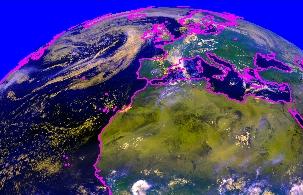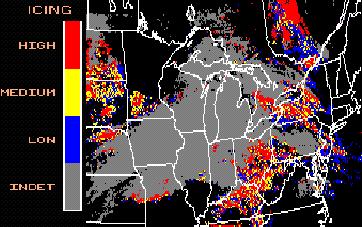|
|
|
|
|
|
|
|
|
|
|
|

|

Icing intensity derived from GOES-8 Jan 28, 2003 20:15 UTC |
|
The EUMETNET Composite Observing System (EUCOS) Program and THORPEX share a common goal of testing the hypothesis that the number and size of significant weather forecast errors over Europe and Eastern seaboard of the USA can be reduced by targeting extra observations over oceanic storm-tracks and other sensitive areas. The Atlantic-THORPEX Regional Campaign (ATReC) is being lead by EUCOS as a field campaign to make a significant contribution towards this common goal. THORPEX, as a Global Atmospheric Research Program (GARP), is an international research program to accelerate improvements in the accuracy of 1 to 14-day weather forecasts for the benefit of society and the economy. The program builds upon ongoing advances within the basic-research and operational-forecasting communities, and will make progress by enhancing international collaboration between these communities and with users of forecast products. More information about THORPEX can be found on the THORPEX web site, www.mmm.ucar.edu/uswrp/programs/thorpex.html |
The NASA Langley Research Center is participating in AIRS II to support the research activities of the NASA Aviation Safety Program (AvSP) and the NASA/NOAA/DOD Integrated Program Office (IPO). These Safety Program activities include ASAP - Advanced Satellite Aviation-weather Products (ASAP) and TAMDAR - Tropospheric Airborne Meteorological Data and Reporting. ASAP is a partnership with the FAA Aviation Weather Research Program (AWRP) to infuse current and next-generation satellite data and applications into FAA AWRP nowcasting products for aviation weather hazards including in-flight icing, convective weather, ceiling & visibility, turbulence and volcanic ash. The TAMDAR instrument was developed by NASA for commercial and private general aviation (GA) to extensively augment the MDCRS and AMDAR data stream and to increase weather awareness in the GA cockpit. The IPO supports the the NPOESS Atmospheric Sounder Testbed Project to develop the next generation of hyperspectral sounders that will fly on operational polar orbiting satellites. This research also supports GIFTS (the Geosynchronous Imaging Fourier Transform Spectrometer), a demonstration instrument for the development of the next generation of GOES (Geostationary Operational Environmental Satellite) sounders. |